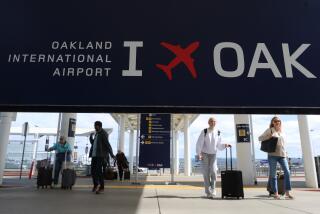In Compton, a runway from the past with an eye on the future
- Share via
Walking into the 85-year-old Compton Airport is like coming upon a secret. There is no massive landmark like the Theme Building at LAX, or lighted letters pointing out the entrance. There aren’t even signs on the freeway directing people to the oldest airport in the Los Angeles Basin.
“It’s a hidden gem. It’s also a very important asset to the city,” said Dennis Lord, a Los Angeles County aviation commissioner. “Most cities don’t have airports. Compton does.”
Compton/Woodley Airport is one of the survivors in a county that had as many as 75 airports in the late 1950s, when general aviation was hitting its stride. But if the airfield seems to have disappeared as the city has swelled around it, veteran pilots can spot it easily enough from the sky.
With his eyes focused on the control panel, Lord cuts through the sky above Los Angeles in his Cessna 182. Although he’s been flying for more than three decades, the 62-year-old doesn’t indulge in idle chatter as he prepares for landing.
He lowers a visor to shield his eyes from the sun as he slows from 160 mph to 70 mph. High above the streets of Compton, it feels like a jarring halt. His hands operate quickly, but in unison. He is focused as he pushes in on the yoke and glides past the city courthouse on his descent. The landing is bumpy and the plane bounces on the asphalt runway before coming to a stop.
As Lord climbs from the plane, the airport at Alondra Boulevard and Wilmington Avenue is nearly as silent as a ghost town. The airport is home to more than 200 planes, most of them hitched to the pavement as if waiting for their owners to point them skyward. A mechanic rides his bike near the runway, the wind whipping through his red flannel shirt. A small plane takes off but the only other sounds are rap music blaring from the cars whizzing by on the other side of the airport’s concrete walls.
Andrew Marino, manager of the airport, said he’s surprised more people don’t know the airport exists.
“Every time I tell people I work at Compton Airport they are like, ‘I didn’t know Compton had an airport,’ ” Marino said with a laugh. “I hear that twice a week.”
Marino said the airport, which opened in 1924, is often used by local law enforcement and the federal government. There is also an annual air show hosted by the California Black Aviation Assn.
A substantial chunk of the airport is Tomorrow’s Aeronautical Museum, a nonprofit organization that provides children as young as 8 the opportunity to learn about aviation, Marino said. And although the rest of the airport is quiet, the sounds of children echo inside one of the classrooms with flight simulators.
Maurice Andrews, youth coordinator for the organization, said the program provides youngsters with a rare opportunity.
The students perform community service in exchange for flight time on a simulator -- 30 hours of service for every hour of flight time. They can also get credit for being tutored in their school subjects.
“A lot of the kids think it’s impossible to get the hours,” Andrews said. “But you have to be 17 to get your license so those hours accumulate.”
Lord said he always felt the airport wasn’t getting its fair share of resources, which could have something to do with the perceptions of the city.
“Compton was the stepchild of county airports. Some of the others were getting more attention,” Lord said.
Lord said programs like Tomorrow’s Aeronautical Museum will bring more visibility to the airport, especially because a handful of youngsters in the program are record holders, such as a 15-year-old who is the youngest African American female to complete a cross-country flight.
For the time, however, the airport remains a secret for those inside its walls.
“There’s such freedom to flying. It’s the passion in us aviators,” Lord said. “You can’t always describe it to the average person outside the fence.”
More to Read
Sign up for Essential California
The most important California stories and recommendations in your inbox every morning.
You may occasionally receive promotional content from the Los Angeles Times.











